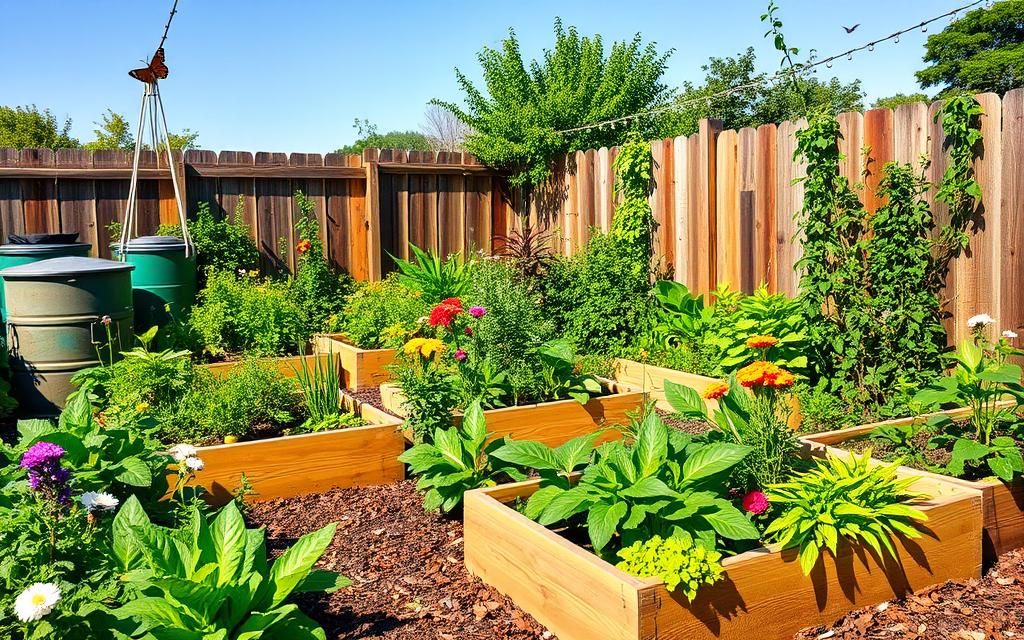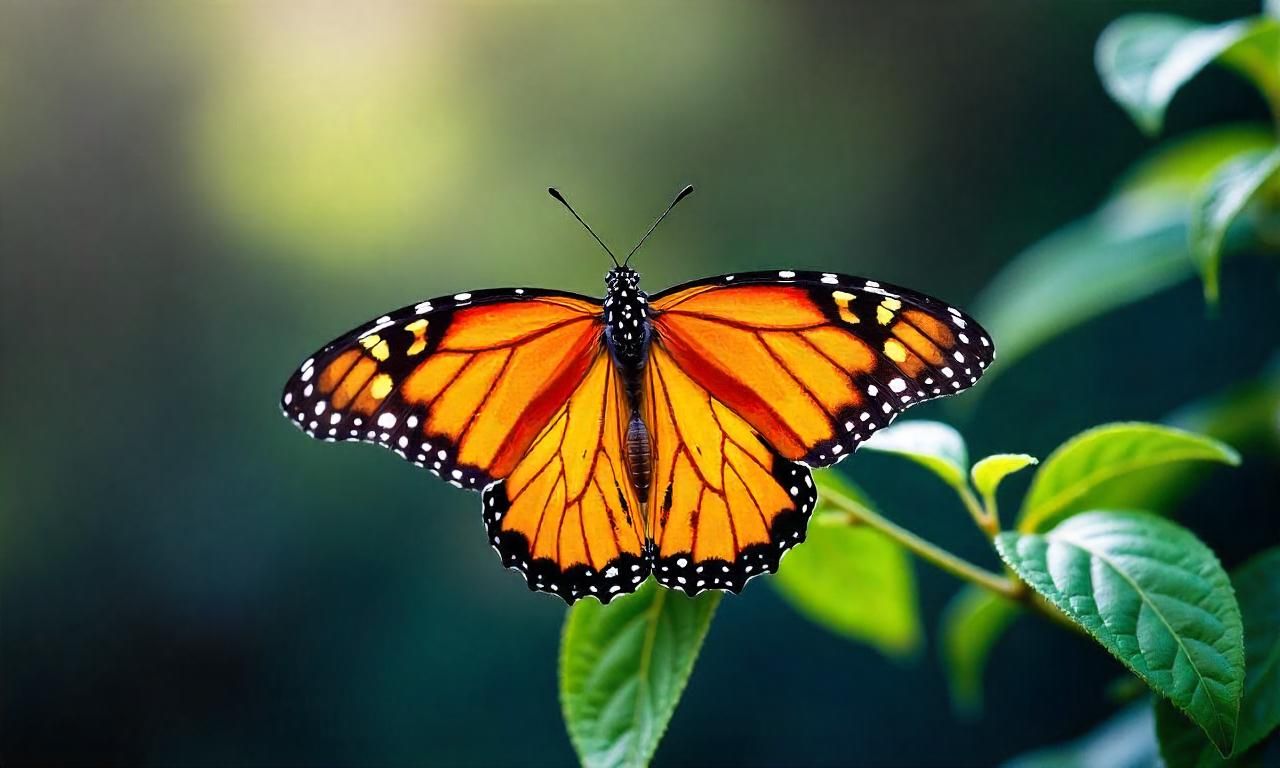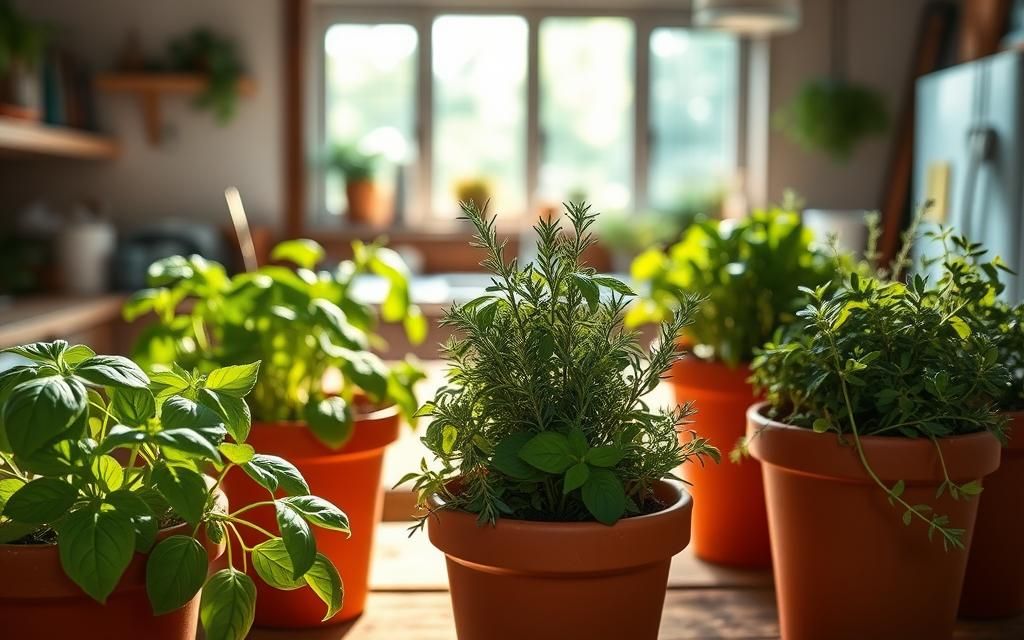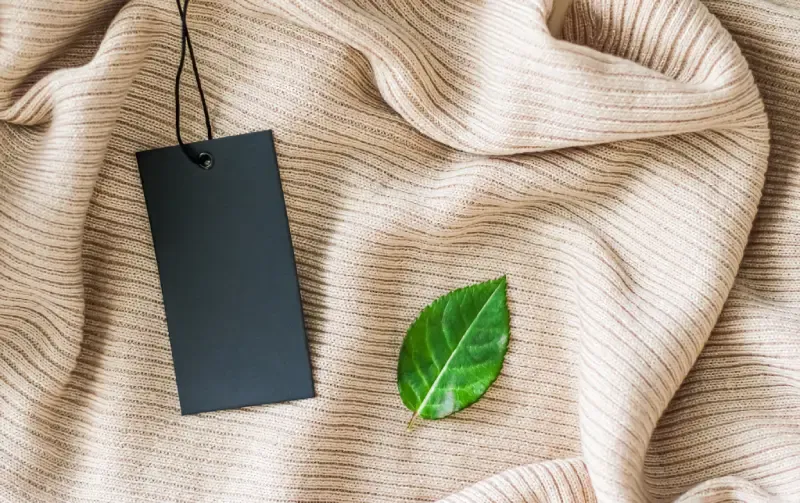Learn how to build an eco-friendly home garden with sustainable practices, saving resources, and creating a green space that benefits you and the planet.
Ever thought of making your backyard a green oasis? It’s good for the planet and boosts your health. Creating an eco-friendly garden is rewarding and key to living sustainably.
We’ll use tips from the Environmental Protection Agency and the National Gardening Association. They offer insights into making your garden green.
Let’s explore ways to make your outdoor area a haven for the environment. It will also improve your life.
Table of Contents
ToggleUnderstanding the Basics of Eco-Friendly Gardening
Eco-friendly gardening makes our gardens better for nature and us. It helps the environment and our backyards. This way, our gardens grow well without harming the planet.
What is Eco-Friendly Gardening?
Eco-friendly gardening is about growing gardens that are good for the planet. It uses compost, rain barrels, and plants that need less water. These steps save resources and help local animals.
The Benefits of an Eco-Friendly Home Garden
Eco-friendly gardens are great for the environment. They use less water and no harmful chemicals. They also help local animals and keep ecosystems healthy.
| Conventional Gardening | Eco-Friendly Gardening |
|---|---|
| High water usage, often leading to waste | Efficient water-saving techniques, like drip irrigation |
| Use of chemical fertilizers and pesticides | Organic composting and natural pest control |
| Limited consideration for local wildlife | Habitat creation for local species |
| Higher operational costs | Cost-efficient and resource-conserving practices |
Choosing eco-friendly gardening helps our planet and local areas. The American Horticultural Society shows how it works. Homeowners have made gardens that are good for the environment and look great.
Choosing the Right Location for Your Garden
Finding the perfect spot for your garden is key to its success. We need to think about sunlight, soil quality, and water access. Let’s explore these factors to pick the best location for our garden.
Sunlight Requirements
Sunlight is crucial for a healthy garden. Most plants need 6-8 hours of direct sunlight each day. We should watch how sunlight moves in our yard to find the sunniest spot. Using garden sunlight mapping can help us pinpoint the best area.
Soil Quality and Drainage
Before we start, we must check our soil. We need to know its texture, pH level, and nutrient content. The U.S. Department of Agriculture has soil testing to help us understand our soil.
Good drainage is also important to avoid waterlogged soil. Raised beds and organic matter can help with drainage and soil quality.
Proximity to Water Source
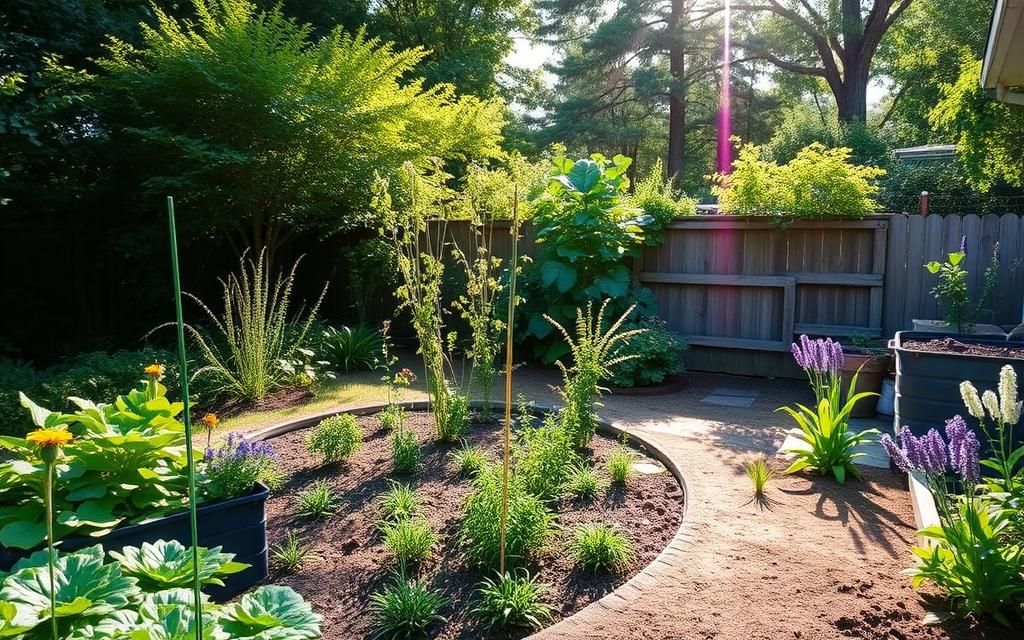
Having water nearby is very helpful. It makes watering easier and helps us save water. A nearby water source allows for easy setup of drip irrigation, which saves water and keeps plants moist.
Selecting Sustainable Plants
Choosing the right plants is key to a green home garden. Focus on native species and drought-resistant plants. These not only save water and effort but also help the local ecosystem.
Native Plants
Native plants are a wise choice for any garden. They grow well in their natural habitats and need less care. The Native Plant Society of America says they use less water and no harmful chemicals.
By using native plants, we help local wildlife like birds and bees. This makes our gardens healthy and our environment cleaner.
Drought-Resistant Varieties
Drought-tolerant gardening means picking plants that need little water. This is vital in dry areas or where water is scarce. Plants like lavender and succulents save water and are easy to care for.
Here’s a list of drought-resistant plants for different areas. This helps you pick the best for your garden.
Right plant choices can turn your garden into a green oasis. Let’s choose native and drought-resistant plants. This way, our gardens will be stunning and good for the planet.
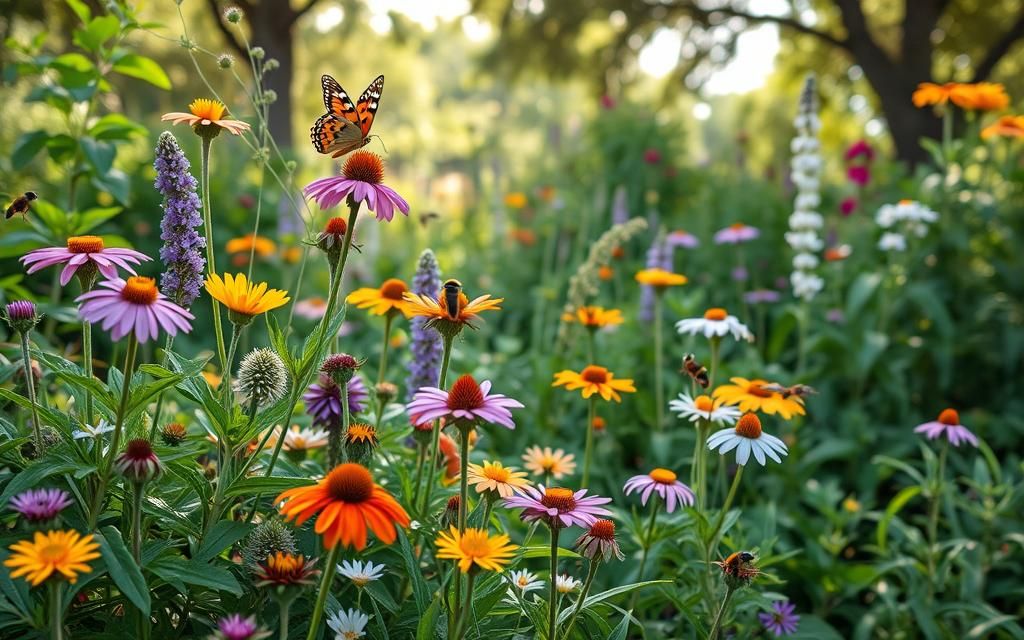
| Region | Native Plants | Drought-Resistant Plants |
|---|---|---|
| Western US | California Poppy, Blue Elderberry | Lavender, Sagebrush |
| Midwestern US | Prairie Blazing Star, Purple Coneflower | Yarrow, Hens and Chicks |
| Southeastern US | Southern Magnolia, Oakleaf Hydrangea | Coral Bells, Lantana |
| Northeastern US | Red Maple, Eastern Redbud | Daylilies, Sedum |
Implementing Water-Saving Techniques
Conserving water in your garden is easy with the right techniques. Drip irrigation systems and rainwater harvesting are great ways to save water. They help us use less water and make our gardens more sustainable.
Drip Irrigation Systems
Drip irrigation systems are very efficient for gardeners. They deliver water right to the roots, cutting down on evaporation and runoff. This means plants get just the right amount of water, without wasting any.
To set up a drip system, you lay out tubes with emitters near your plants. It’s a simple way to save water.
Using drip irrigation has many benefits:
- It can cut water use by up to 50% compared to sprinklers.
- It prevents soil erosion and keeps nutrients in the soil.
- It keeps plants dry, which helps prevent diseases.
With a guide from the Conservation Technology Information Center, anyone can install a drip system.
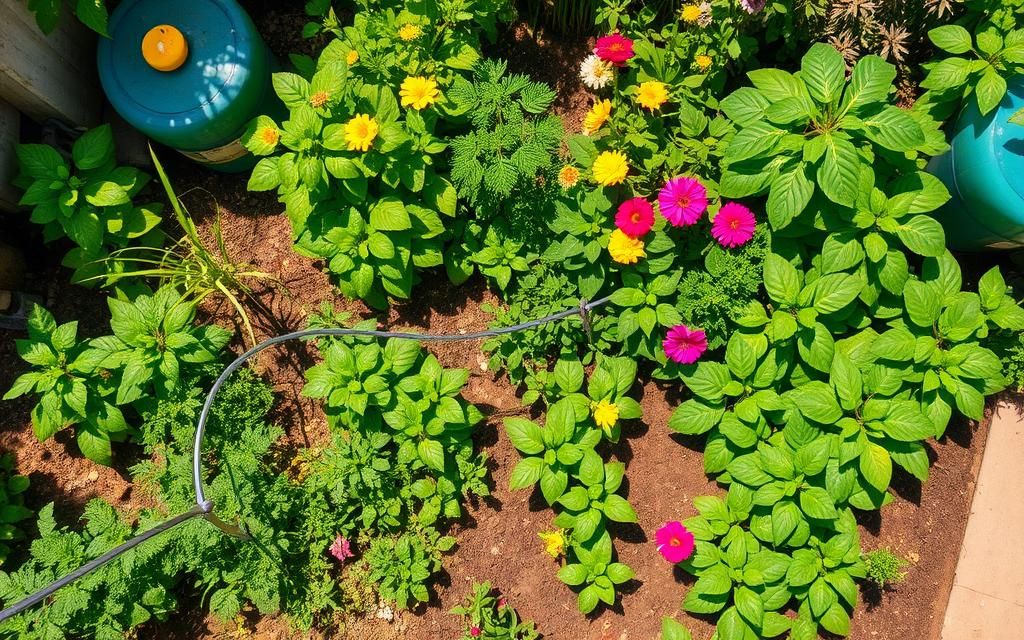
Rainwater Harvesting
Rainwater harvesting is another smart way to save water. It lets us collect and store rainwater for our gardens. This way, our gardens stay watered even when it’s dry outside.
Here’s how to set up a rainwater collection system:
- Put up gutters and downspouts to catch rainwater from your roof.
- Use a rain barrel or cistern to hold the water.
- Connect hoses or a drip system to the barrel to water your garden.
The American Rainwater Catchment Systems Association says rainwater collection has many benefits. It reduces stormwater runoff, lowers water bills, and gives plants good, mineral-rich water.
By using these water-saving methods, we help our gardens and the planet. Let’s make our gardens more sustainable with efficient irrigation and water-saving techniques.
Building and Maintaining Healthy Soil
Keeping our soil healthy is key for a green garden. Natural methods help our plants get what they need without harming the planet. We’ll explore composting, organic mulching, and avoiding harmful fertilizers. These methods are backed by the Organic Materials Review Institute and the Soil Science Society of America.
Composting
Composting turns waste into a soil booster. It makes soil better, holds more water, and helps good bugs. It’s good for the planet too, by cutting down on landfill waste.
To compost well, mix green stuff like fruit peels with brown stuff like leaves. Keep it damp and let it breathe.
Using Organic Mulch
Organic mulch keeps soil warm, fights weeds, and saves water. It breaks down slowly, making soil better over time. Straw, wood chips, and leaves are great choices.
The Organic Materials Review Institute says to use mulch without pesticides. This keeps your garden safe and healthy.
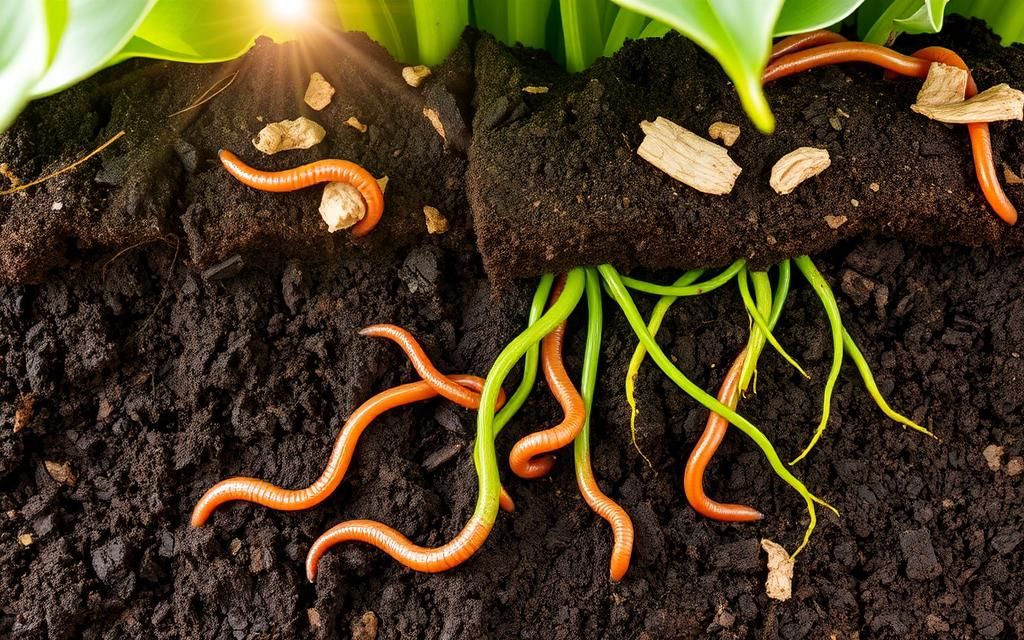
Avoiding Chemical Fertilizers
Staying away from synthetic fertilizers is a core part of green gardening. They might give a quick fix, but they can harm soil and plants in the long run. Instead, use compost and natural stuff like bone meal or fish emulsion.
By doing this, we make our soil strong and our garden grow well.
| Method | Advantages | Considerations |
|---|---|---|
| Composting | Provides nutrients, reduces waste, enhances soil structure | Needs regular aeration and moisture control |
| Organic Mulch | Improves soil health, conserves water, reduces weeds | Must be pesticide-free |
| Avoiding Chemical Fertilizers | Preserves soil microbiota, prevents nutrient imbalances | Requires consistent organic amendments |
How to Build an Eco-Friendly Home Garden Step by Step
Starting an eco-friendly home garden needs a good plan. Our guide will walk you through each step. This ensures a smooth garden design and a sustainable setup.
First, plan your garden. Look at your backyard or space carefully. Decide where to plant, considering sunlight and soil. Green America’s garden blueprints can give you great ideas.
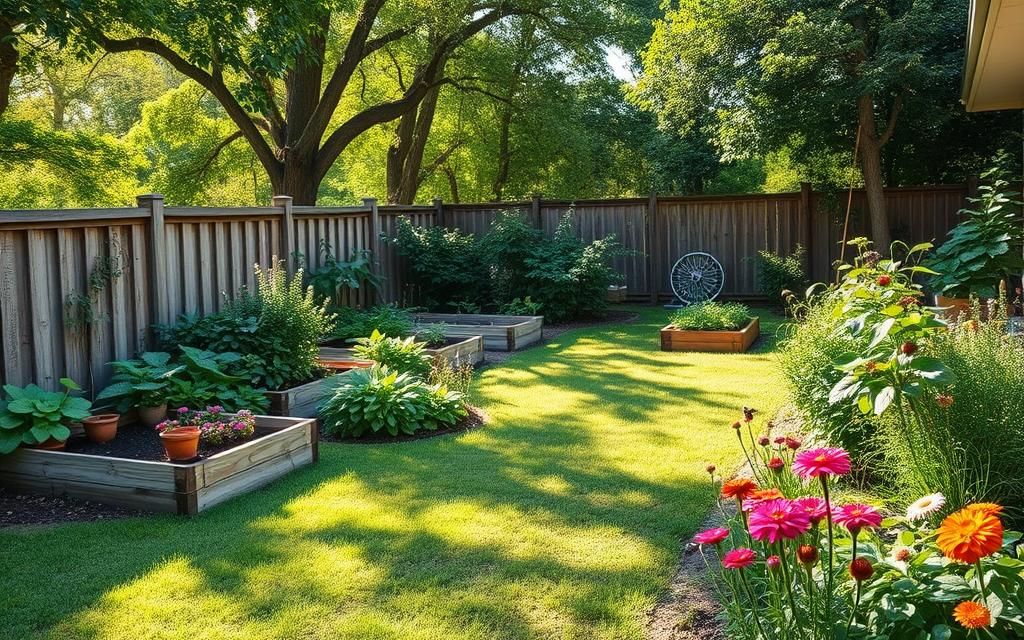
Then, pick sustainable materials and plants. Choose native and drought-resistant ones that need little water. Green America shows how these plants help biodiversity and save resources.
After picking plants, arrange them wisely. Put plants needing the same water and sunlight together. This saves resources and helps plants grow better.
Keeping your garden eco-friendly is key. Use water-saving systems like drip irrigation and collect rainwater. Add organic compost to the soil and avoid harmful fertilizers.
- Plan your garden layout based on space and sunlight.
- Choose sustainable materials and native plants.
- Arrange plants by their needs.
- Use water-saving techniques.
- Keep the soil healthy with organic methods.
By following these steps, you’ll have a beautiful and sustainable garden. It will greatly improve our environment.
| Stage | Action | Benefit |
|---|---|---|
| Planning | Assess space, map out areas | Optimizes resource usage |
| Material selection | Choose native and drought-resistant plants | Enhances biodiversity, minimal water usage |
| Plant arrangement | Group by water and sunlight needs | Healthier plant growth, efficient resource use |
| Water-saving techniques | Use drip irrigation and rainwater harvesting | Conserves water |
| Maintaining soil health | Use organic compost, avoid chemicals | Eco-friendly, soil enrichment |
In summary, our guide makes planning and setting up a sustainable garden easy. Let’s create gardens that are beautiful and good for our planet.
Incorporating Wildlife-Friendly Practices
By making our gardens wildlife-friendly, we create a safe space for local animals. This also boosts garden biodiversity and helps our ecosystem thrive. The National Wildlife Federation’s Garden for Wildlife program highlights the need for habitats and resources for wildlife. Here, we’ll look at steps to turn your garden into a wildlife sanctuary.
Providing Habitats
Attracting wildlife starts with varied habitats. Make sure your garden has trees, shrubs, and water sources. Native plants are key, as they feed and shelter local species.
Installing Bird Feeders and Baths
Bird feeders and baths help local bird populations. They control pests and pollinate, making your garden healthier. Place them safely and clean them often to keep wildlife healthy. Different feeders attract more bird species, boosting your garden’s diversity.
| Key Element | Benefit |
|---|---|
| Native Plants | Supports local fauna and promotes garden biodiversity |
| Bird Feeders | Attracts birds, aiding in pest control and pollination |
| Bird Baths | Provides water sources, crucial for wildlife survival |
Reducing Waste in Your Home Garden
Using waste reduction techniques in our gardens makes them greener and more sustainable. By choosing sustainable gardening materials and managing green waste well, we cut down waste. This helps make our gardening more eco-friendly.
Recycling Yard Waste
To recycle yard waste, follow the U.S. Composting Council’s advice. Composting grass clippings and leaves adds nutrients to the soil. This reduces the need for chemical fertilizers. Using compost bins or areas in our garden helps organic matter decompose well, supporting plant health.
- Gather yard trimmings like leaves, grass clippings, and small branches.
- Put these materials in a compost bin or designated pile.
- Turn the compost often to help it decompose faster.
- Use the compost to make garden soil richer and plants healthier.
Using Biodegradable Containers
Choosing biodegradable containers is a smart way to reduce waste. These are made from natural materials like coir and peat. They break down naturally, reducing plastic waste and keeping our gardening green.
Biodegradable containers help prevent root circling and make transplanting easier. They also decompose, adding organic matter to the soil. Using these containers in your garden supports green waste management and promotes a healthier environment.
Conclusion
Our journey into eco-friendly gardening shows its big impact on our environment and health. We start with basics like picking the right spot and choosing green plants. Using water-saving methods like drip irrigation helps our plants and saves water.
Creating healthy soil with compost and organic mulch is key. Avoiding harmful chemicals is also important. Adding wildlife-friendly features like bird feeders makes our gardens better for all living things.
By following these eco-friendly steps, we make our gardens beautiful and help the Earth. We should keep learning and growing in our gardening journey. Every small step we take helps our planet and future generations.
Ready to create a sustainable garden? Visit ecowarriornation.com for expert tips on how to build an eco-friendly home garden and start your green journey today!
FAQ
What is eco-friendly gardening?
Eco-friendly gardening, also known as sustainable gardening, aims to reduce environmental impact. It uses practices that conserve resources and promote biodiversity. This way, our gardens are good for us and the planet.
Why should we consider building an eco-friendly home garden?
An eco-friendly home garden has many benefits. It reduces our carbon footprint, saves water, and supports local wildlife. The National Gardening Association says it also boosts mental well-being and gives us fresh produce.
How do we choose the right location for our eco-friendly garden?
Choosing the right spot involves understanding sunlight, soil quality, and drainage. Make sure it’s near a water source for efficient irrigation. The U.S. Department of Agriculture offers tools for garden planning.
What types of plants are best for an eco-friendly garden?
Native plants and drought-resistant varieties are best. Native plants need less water and fewer fertilizers. The Native Plant Society of America helps choose the right plants. Drought-resistant plants also save water.
What water-saving techniques can we implement in our garden?
Use drip irrigation and rainwater harvesting to save water. Drip irrigation delivers water directly to roots, reducing waste. Rainwater harvesting stores rainwater for later use. The Conservation Technology Information Center has setup guides.
How do we build and maintain healthy soil sustainably?
Focus on composting, organic mulch, and avoid chemical fertilizers. Composting enriches soil, and mulch retains moisture and controls weeds. Organic Materials Review Institute standards help with these practices.
Can you guide us through building an eco-friendly home garden step by step?
Sure! Start with a garden design, considering location, plant types, and materials. Prepare the soil, install irrigation, and plant. Regular composting, mulching, and water conservation maintain your garden. Green America has blueprints for green gardens.
How can we incorporate wildlife-friendly practices into our garden?
Create habitats with bird feeders and baths. This supports local biodiversity and a healthy ecosystem. The National Wildlife Federation’s Garden for Wildlife program offers advice on garden biodiversity.
What are some effective ways to reduce waste in our home garden?
Reduce waste by composting yard trimmings and using biodegradable containers. These practices make our garden sustainable. The U.S. Composting Council and biodegradable materials help.

